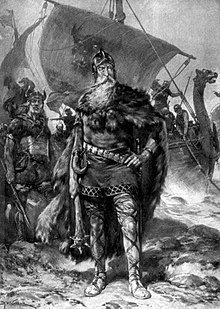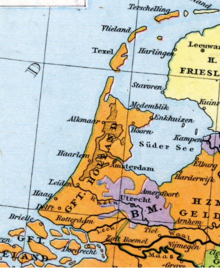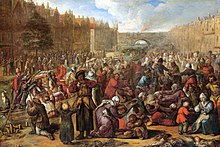County of Holland
County of Holland Comitatus Hollandiae () | |||||||||
|---|---|---|---|---|---|---|---|---|---|
| 1091/1190–1431/1795 | |||||||||
| Motto: "Vigilate Deo confidentes" (Latin) "Watch, trusting in God" | |||||||||
Dutch Reformed | |||||||||
| Government | Feudal monarchy | ||||||||
| Count | |||||||||
• 880–896 | Gerolf (first) | ||||||||
• 1555–1581 | Phillip II (last) | ||||||||
| Stadtholder | |||||||||
• 1433–1440 | Hugo (first) | ||||||||
• 1672–1702 | William III (last) | ||||||||
| Legislature | Modern | ||||||||
• Established | 11th century | ||||||||
| 26 July 1581 | |||||||||
| 18 January 1795 | |||||||||
| |||||||||
| Today part of | Netherlands | ||||||||
The County of Holland was a
The County of Holland was the first Holy Roman county in the area to reach the level of economic, cultural, military, and technological development it did, having had time to undergo this development before the area became classed as a county.[1]
Etymology
The oldest sources refer to the not clearly defined county as
History
Francia and Lotharingia
Around 800, under
Upon the death of a king, the Frankish kingdom was frequently divided among his heirs. The system of
When Lothair died in 855, the northern part of Middle Francia was awarded to his second son, Lothair II, and was called Lotharingia.
Rorik was granted the right to rule Kennemerland in 862.[1]
The 880 Treaty of Ribemont added the Kingdom of Lotharingia (which included the Low Countries) to East Francia, which attempted to integrate it. However, there were no strong political connections like those between the four German stem duchies of east Francia: Franconia, the Saxony, the Bavaria and the Swabia. Lotharingia had considerable self-determination; this became clear when Louis the Child, East Francia's last Carolingian, died in 911. Although the stem duchies flocked to Duke Conrad I of Franconia, Lotharingia chose the Carolingian king of West Francia, Charles the Simple.

In Frisia, the situation was complex. Power was in the hands of Rorik's successor,
After the elimination of a large portion of the Danish population, Gerulf controlled a large Frisian part of the later county of Holland. This fait accompli was recognised when Gerolf was given lands
King
Imperial State
The rising status of the
The County of Holland and other nearby territories had a considerable amount of independence from Holy Roman Empire leadership in the 10th and 11th centuries.[1] Until at least the second half of the 10th century, Holland's leadership valued secular principles, a contrast to the nearby Prince-Bishopric of Utrecht.[1]
The count of Holland was in this period more of a military commander who had to resist Viking raids, and be subject to the authority of the
In 993, count Arnulf of Ghent was killed in a battle against Frisian land reclaimers who did not want to pay their due to the count. It is unknown where this battle took place but it was probably in the Rijnland or in the Maas estuary. Arnulf's son, count Dirk III of Holland was too young to rule, so his mother Lutgardis of Luxemburg acted as regent. In 1005 Dirk was old enough to rule in his own name, but he still made thankful use of the good connections that his mother had made. According to Thietmar of Merseburg, a reconciliation with the Frisians was arranged with help from his uncle-in-law, king Henry II, who travelled with an army and a fleet from Utrecht to the Maas-estuary (probably Vlaardingen) to force the inhabitants to recognize their count. This expedition appears to have been successful since after 1005 no revolts against the count in this southern part of the later county of Holland are known.


As a result of a promise he had made during the Frisian rebellion, Dirk III went on a pilgrimage to Jerusalem. When he returned, the northern side of his county had become unsafe, so he travelled south and started granting rights to reclaim lands from nature around present-day
So as not to weaken the protection the county of Holland offered against the Viking raids, King Henry II decided to let the matter rest, though he did strengthen the position of the Bishop of Utrecht, the nominal feudal lord of the counts of Holland. Nonetheless, Dirk managed to expand his territory to the east at the cost of the Bishopric of Utrecht. After the death of Henry II in 1024, Dirk III supported the candidature of Conrad II in an attempt to reconcile with the imperial authorities, so as to keep the lands he had acquired or expand them even further.[citation needed]
Emperor Conrad II died during a stay in Utrecht in 1039 during the rule of bishop
Floris I managed to expand his territory with a small area within the Rijnland Gouw, an area called Holtland ("Woodland"), or Holland. It is most likely that this name soon became synonymous with Floris' whole territory. In 1061 a war broke out, in which it is not clear whether it was against Brabant, Utrecht or Liège. During this war, Floris was ambushed while relaxing too much and in too small a company when he was raiding in the former Teisterbant county, now Utrechtian territory. He was killed by either Utrechtian or Gueldrian troops. His son Dirk V was still a minor, so his mother Gertrude of Saxony became regent. Gertrude remarried in 1063 with Robert the Frisian, a younger brother of the count of Flanders, Baldwin VI and a grandson of a former French king, Robert II, who also acted as regent for Dirk V.[citation needed]
In 1064, Emperor
Holland's influence continued to gradually grow over the next two centuries. The counts of Holland were able to conquer most of
Burgundians and Habsburgs


The
Under the Burgundians, Holland's trade developed rapidly, especially in the areas of shipping and transport. The new rulers defended Dutch trading interests. The fleets of Holland defeated the fleets of the Hanseatic League several times. Amsterdam grew and in the 15th century became the primary trading port in Europe for grain from the Baltic region. Amsterdam distributed grain to the major cities of Belgium, Northern France and England. This trade was vital to the people of Holland, because Holland could no longer produce enough grain to feed itself. Land drainage had caused the peat of the former wetlands to reduce to a level that was too low for drainage to be maintained.
Charles (1500–58) became the owner in 1506, but in 1515 he left to become king of Spain and later became the Holy Roman Emperor. Charles turned over control to regents (his close relatives), and in practice rule was exercised by mostly French speaking Burgundians he controlled. Holland retained its own governments and court, controlled by the local nobility, and its own traditions and rights ("liberties") dating back centuries. Likewise the numerous cities had their own legal rights and local governments, usually controlled by the merchants, On top of this, however, the Burgundians had imposed an overall government, the Estates General of the Netherlands, with its own officials and courts.[2]
Revolt and the Dutch Republic

During the 16th century, the

The States General of the Netherlands signed the
Nominally, the County of Holland formally came to an end in 1795, when the Batavian Revolution ended the republic and reformed it as the Batavian Republic. The territory of the former county was divided between the departments of the Amstel, Delf, Texel, and Schelde en Maas. After 1813, Holland was restored as a province of the United Kingdom of the Netherlands. Holland was divided into the present provinces North Holland and South Holland in 1840.
Geography
The county covered an area roughly corresponding to the current Dutch provinces of North Holland and South Holland, as well as the northwestern part of the current province of North Brabant (roughly between the towns of Willemstad, Geertruidenberg and Werkendam), and the islands of Terschelling, Vlieland, Urk and Schokland, though it did not include the island of Goeree-Overflakkee.
In the early Middle Ages, large parts of the area covered by the present-day Netherlands were covered by peat bogs. These bogs limited the size of arable land in the Netherlands, but also proved to be a good source of fuel. Around 950, small-scale reclamation was started on the enormous bogs in Holland and Utrecht, probably set in motion by the minor nobility. In the 11th century the 'Great Reclamation' started, under the control of the counts of Holland and the bishops of Utrecht. Until the 13th century, large amounts of land were reclaimed between the IJ bay in the north, the dunes in the west, the Lek and Waal rivers in the south and the Old Rhine in the east.
Before the Great Reclamation, the borders between the county of Holland and the bishopric of Utrecht were unclear, and there existed a literal
See also
- Count of Holland
- Counties of the Holy Roman Empire
References
- ^ OCLC 52849131.
- ^ H.G. Koenigsberger, "The Beginnings of the States General of the Netherlands", Parliaments, Estates and Representation (1988) 8#2 pp 101-114.
- ^ R. Po-chia Hsia, ed. A Companion to the Reformation World (2006) pp 118-34
- ^ Jonathan I. Israel, The Dutch Republic Its Rise, Greatness, and Fall 1477–1806 (1995) p. 104
- ^ Hsia, ed. A Companion to the Reformation World (2006) pp 3-36
- ^ Jerome Blum et al, The European World: A History (1970) pp 160-61
- ^ Israel, The Dutch Republic: Its Rise, Greatness, and Fall, 1477-1806 (1995) pp 361-95
- ^ Diarmaid MacCulloch, The Reformation (2005) pp 367-72
Bibliography
- Block, Dick (1977–1983). Algemene Geschiedenis der Nederlanden. Haarlem: Fibula-Van Dishoeck. ISBN 90-228-3800-5.
- Lamberts, J.C.H. (2006). Geschiedenis van de Nederlanden. Baarn: HBuitgevers. ISBN 90-5574-474-3.
- Graaf, A.C.F. (1970). Oorlog om Holland 1000-1375. Hilversum: Verloren. ISBN 90-6550-807-4.
- Koch, A.C.F. (1970). Oorkondenboek van Holland en Zeeland tot 1299, Deel I – einde 7e eeuw tot 1222. Den Haag: Nijhoff. ISBN 90-247-0403-0.
- Beukers, T. de (2002). Geschiedenis van Holland tot 1572. Hilversum. ISBN 90-6550-682-9.)
{{cite book}}: CS1 maint: location missing publisher (link

